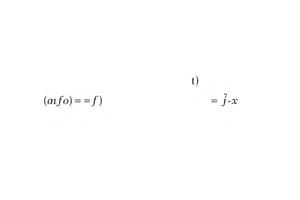Podcast
Questions and Answers
What is the domain of a relation?
What is the domain of a relation?
- The range of the relation
- The set of all input values (correct)
- The ordered pairs in the relation
- The set of all second coordinates
In the context of relations, what does the range represent?
In the context of relations, what does the range represent?
- The set of first coordinates of ordered pairs
- The independent variables
- The set of all output values (correct)
- The input values in the relation
In the relation H = {(1, 72),(2, 64),(3, 60),(4, 57),(5, 71)}, what is the range?
In the relation H = {(1, 72),(2, 64),(3, 60),(4, 57),(5, 71)}, what is the range?
- {0, 1, 4}
- {72, 64, 60, 57, 71} (correct)
- {1, 2, 3, 4, 5}
- {2, 4, 6, 8, 10}
What does the domain {x | x is a real number and x ≥ 0} represent?
What does the domain {x | x is a real number and x ≥ 0} represent?
In a graph where the domain extends from -8 to 8 and the range from -5 to 5, how would you express the range in set-builder notation?
In a graph where the domain extends from -8 to 8 and the range from -5 to 5, how would you express the range in set-builder notation?
What does an open circle on a graph represent?
What does an open circle on a graph represent?
What is an ordered pair?
What is an ordered pair?
How are ordered pairs used in relations and functions?
How are ordered pairs used in relations and functions?
In the context of functions, what does the 'domain' refer to?
In the context of functions, what does the 'domain' refer to?
What is the purpose of deriving the inverse function of a given function?
What is the purpose of deriving the inverse function of a given function?
How are sets of ordered pairs related to relations or functions?
How are sets of ordered pairs related to relations or functions?
What distinguishes the pair (8, 5) from (5, 8) in mathematics?
What distinguishes the pair (8, 5) from (5, 8) in mathematics?
Study Notes
Relations and Functions
- A relation is a set of ordered pairs, where each pair consists of two elements, one coming first (input value or independent variable) and the other coming second (output value or dependent variable).
- The domain of a relation is the set of all first coordinates (input values), while the range is the set of all second coordinates (output values).
Ordered Pairs
- An ordered pair is a pair of numbers written within a set of parentheses and separated by a comma, such as (5, 8), where the order is designated by the first element (5) and the second element (8).
- The pair (8, 5) is not the same as (5, 8) due to the different ordering.
Examples of Relations
- The pairing of names and ages in a community is a relation, where each name is paired with a corresponding age.
- The pairing of student numbers and their corresponding heights is a relation, which can be written as a set of ordered pairs.
- The relation M = {(0, 0), (-6, 4), (1, 4), (-3, 4)} has a domain of {-6, -3, 0, 1} and a range of {0, 1, 4}.
Domain and Range Notation
- The domain and range can be expressed in set-builder notation or interval notation, such as {x | x is a real number and x ≥ 0} or [0, +∞) for the domain, and {y | y is any real number} or (-∞, +∞) for the range.
Graphical Representation
- Relations can be represented graphically in a rectangular coordinate system, where the domain consists of x-values and the range consists of y-values.
- The graph of a relation can help visualize the domain and range, such as the graph with a domain of [-8, 8] and a range of [-5, 5].
Studying That Suits You
Use AI to generate personalized quizzes and flashcards to suit your learning preferences.
Description
Test your understanding of relations and functions in Mathematics with this quiz based on Chapter I of the textbook 'Mathematics in the Modern World GEC 14 Teachers'. Explore how pairs of names and ages form ordered relations, and how to navigate between the two concepts effectively.




